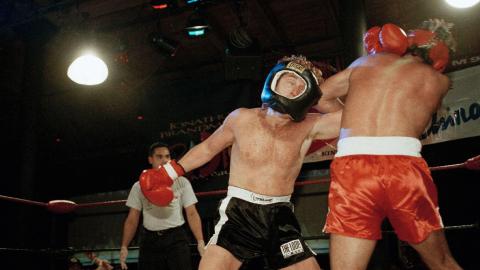On this day in 1929 in Chicago, gunmen in the suspected employment of organised-crime boss Al Capone murder seven members of the George "Bugs" Moran North Siders gang in a garage on North Clark Street. The so-called St. Valentine's Day Massacre stirred a media storm centred on Capone and his illegal Prohibition-era activities and motivated federal authorities to redouble their efforts to find evidence incriminating enough to take him off the streets. Alphonse Capone was born in Brooklyn in 1899, the son of Italian immigrants from Naples. The fourth of nine children, he quit school after the sixth grade and joined a street gang. He became acquainted with Johnny Torrio, a crime boss who operated in Chicago and New York, and at the age of 18 Capone was employed at a Coney Island club owned by gangster Frankie Yale. It was while working there that his face was slashed in a brawl, earning him the nickname "Scarface."
In 1917, his girlfriend became pregnant and they married, and the couple moved with their son to Baltimore, where Capone attempted a respectable life working as a bookkeeper. In 1921, however, his old friend Johnny Torrio lured him to Chicago, where Torrio had built up an impressive crime syndicate and was beginning to make a fortune on the illicit commerce of alcohol, which was banned in 1919 by the 18th Amendment to the Constitution. Capone demonstrated considerable business acumen and was appointed manager of a Torrio speakeasy. Later, Torrio put him charge of the suburb of Cicero. Unlike his boss, who was always discreet, Capone achieved notoriety as he fought for control of Cicero and was even tried (unsuccessfully) for murder In 1925, Torrio was shot four times by Bugs Moran and Hymie Weiss, who were associates of a gangster slain by Torrio's men. Torrio lived, but four weeks later he appeared in court and was sentenced to nine months stemming from a police raid of a brewery he owned. About a month later, he called Capone from jail to tell him that he was retiring and handing the business over to him.
Capone moved his headquarters to the luxurious Metropole Hotel, where he became a visible figure in Chicago public life as his crime empire steadily expanded. After a prosecutor was killed by some of Capone's henchmen, the Chicago police moved aggressively against his criminal operations, but they couldn't make any charges stick. Capone bought a luxurious estate in Miami as a retreat from all this unwanted attention. Capone was in Florida in February 1929 when he gave the go-ahead for the assassination of Bugs Moran. On 13 February, a bootlegger called Moran and offered to sell him a truckload of high quality whiskey at a low price. Moran took the bait and the next morning pulled up to the delivery location where he was to meet several associates and purchase the whisky. He was running a little late, and just as he was pulling up to the garage he saw what looked like two policemen and two detectives get out of an unmarked car and head to the door. Thinking he had nearly avoided being caught in a police raid, Moran drove off.
The four men, however, were Capone's assassins, and they were only entering the building before Moran's arrival because they had mistaken one of the seven men inside for the boss himself. Wearing their stolen police uniforms and heavily armed, Capone's henchmen surprised Moran's men, who agreed to line up against the wall. Thinking they had fallen prey to a routine police raid, they allowed themselves to be disarmed. A moment later, they were gunned down in a hail of shotgun and submachine-gun fire. Six were killed instantly, and the seventh survived for less than an hour. Americans were shocked and outraged by the cold-blooded Valentine's Day killings, and many questioned whether the sin of intemperance outweighed the evil of Prohibition-era gangsters like Capone. Although, as usual, he had an air-tight alibi, few doubted his role in the massacre.
The authorities, particularly affronted by the hit men's use of police uniforms, vowed to bring him to justice. With a mandate from Herbert Hoover, the new president, the Treasury Department led the assault against Capone, hoping to uncover enough evidence of Prohibition offenses and federal income tax evasion to bring him to justice. In May 1929, Capone was convicted for carrying a concealed weapon and sent to prison for 10 months. Meanwhile, Treasury agents, like Eliot Ness, continued to gather evidence. In June 1931, Capone was indicted for income tax evasion. On 17 October, primarily on the basis of testimony by two former bookkeepers, he was found guilty on several counts. One week later, he was sentenced to 11 years in prison and $80,000 in fines and court costs. He entered Atlanta penitentiary in 1932 and in 1934 was transferred to the new Alcatraz Island prison in San Francisco Bay.
By that time, Prohibition had been repealed, and Capone's empire had collapsed. At Alcatraz, the syphilis Capone had contracted in his youth entered a late stage, and he spent his last year in prison in the hospital ward. In 1939, he was released after only six and a half years in jail as the result of good behaviour and work credits. He was treated in a Baltimore hospital and in 1940 retired to his Miami estate, where he lived until his death in 1947. He was outlived by his rival Bugs Moran, who later died of lung cancer while serving a 10-year sentence in Kansas for bank robbery.








